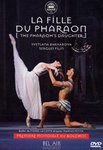|
Back
09/27/2017
Cesare Pugni: La Fille du Pharaon or The Pharaoh’s Daughter (Choreography by Pierre Lacotte after Marius Petipa)
Svetlana Zakharova (Aspicia), Sergei Filin (Lord Wilson/Taor), Maria Aleksandrova (Ramzé), Dimitri Gudanov (the fisherman), Inna Petrova (the fisherman’s wife), Gennady Yanin (John Bull, Passiphonte), Anna Tsygankova, Anastasia Goryatcheva, Denis Medvedev, Yan Godovsky (Grande défilé I-III dancers), Vladimir Moiseev (God of the Nile River), Anastasia Yatsenko (Guadalquivir), Ekaterina Shipulina (Congo), Elena Andrienko (Neva), soloists and dancers of Bolshoi Theatre, students of the State Choreography Academy, orchestra of the State Academic Bolshoi Theatre, Alexander Sotnikov (conductor), Pierre Lacotte (staging, set and costume designer and choreographer), François Duplat (producer), Denis Caïozzi (video director), Alexander Rubtsov (Lighting Designer)
Recording: The Bolshoi Theatre, Moscow, Russia (October 31, 2003) – 130’ (including bonus)
BelAir Classiques #BAC301 (or Blu-ray #BAC401) – PCM 2.0 – Dolby Digital 5.1 –16:9 NTSC – Code Region: 0 (Distributed by Naxos of America) Subtitles in English, German and Spanish – Booklet in English and French

   
Choreographer extraordinaire Pierre Lacotte has great continuity in ballet aesthetics, reaching back to Premier maître de ballet Marius Petipa via associations with Russian ballerinas Mathilda Kschessinska and Lyubov Yegorova. Considered to be Petipa’s first grandiose ballet, La Fille du Pharaon would be one of many ballets preserved under the new archival technique, namely, the “Stepanov Method.” This holds great fascination since M. Lacotte had to decipher Stepanov’s encrypted symbols in order to move forward with his artistic innovation. What lacked in the Stepanov Collection, however, was information concerning arm and leg detail. This gave impetus for M. Lacotte to re-envision the ballet à l’égyptienne, including a paring down of Pugni’s score with updates on the two pas d’action and the “waltz”: now we witness a modernized rendition complimenting Théophile Gautier’s Le Roman de la momie writing that truly generates coherency and fluidity.
Cesare Pugni’s highly approachable, uplifting and Westernized music gives dance an effervescent magnetism, though weak on an Egyptian theme. One can see an irrefutable “Lacotte impression” for those having witnessed his fabulous production of Marco Spada back in 2014. Infusive of grand elegance, there’s an encasement of diagonal lines and geometric symmetry; Pierre Lacotte beautifully masters French ballet technique in honor of the Marseilles-born doyen.
The line-up of principal dancers is nothing short of being an “apex of ballet professionalism.” Svetlana Zakharova (Aspicia) continues to warm balletomanes’ hearts with her innate sense of musicality and graceful impulses, as exemplified in her later 2006 role of Nikiya in La Bayadère: allonges and arabesques melt into formation, particularly when being emphasized by the support of Sergei Filin as Taor. Furthermore, M. Filin wears a cape of masculine mobility and lives his character with athletic charisma; each of their various pas de deux is spot-on synchronistic.
Passages inside La Fille du Pharaon never linger for more than a couple of minutes which keeps the viewer’s attention. To this point, Maria Aleksandrova gains her first solo spotlight in the whimsical Ramzé pas featuring the tapping of her ballet shoes that is aided by four servants. Pugni’s sense of mythical magic was achieved through use of the celesta, and this small segment is no exception. As the male counterpart to Aleksandrova’s servitude character, the stocky Gennady Yanin ignites with a bundle of compact gyrations and adds a degree of comedic delight to his Passiphonte.
Each of the corps de ballet’s chapters colorfully stimulates the senses. The continual retinue entering the stage inside the “Les fiançailles” (“The engagement”) makes one feel we’re watching “The Triumphal March” from Aida. Spectacular!
Two tableaux are vaguely reminiscent of August Bournonville’s blue grotto (Act II) and Naples’ Santa Lucia beach harbor square (Acts I and III) from Napoli (1842.) In fact, La Fille du Pharaon bends more heavily toward a Bournonville mime. The three different vignettes depicting each of the rivers come with their own sense of rhythmic chemistry: Anastasia Yatsenko splashes the stage with a snappy castanet-driven boléro (Guadalquivir) while Congo’s perky depiction is housed inside a wispy 3/4 waltz and danced by talents of Ekaterina Shipulina. Elena Andrienko’s final Neva is split between an oboe-driven melody infused by Russian somberness and a quixotic coda, turning the miniscule pas into a spritely conclusion.
Pierre Lacotte’s dance is taken to “the third power” by brilliantly engulfing us inside palatial sets and anthropological costuming, all done with magnificence under illumination by Alexander Robtsov. François Duplat’s production renders absolute perfection, and under jurisdiction of Denis Caïozzi’s video editing, the DVD is flawlessly executed. This is a collection for anyone and everyone to enjoy. Stupendous!
Christie Grimstad
|